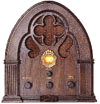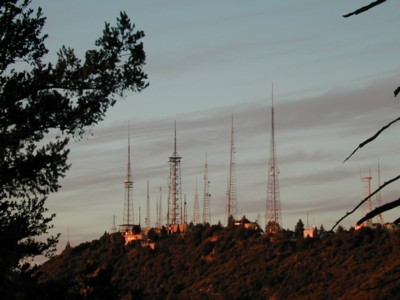
The Story of Mt. Wilson, California
Part 1
Benjamin's Mountain
By Marvin Collins
Benjamin D. Wilson, born in 1811 in Tennessee, was a fur trapper by trade. He arrived in California in 1841, intending to continue to China. During the Mexican War he joined up with the Gringos, was captured, and spent the remainder of the war as a prisoner. After the war he went into business in Los Angeles and was eventually elected mayor in 1851. In 1854 he bought a 128 acre ranch where San Marino now stands and lived there until his death in 1878.

|
|
Mt. Wilson at sunset. Photo by Marvin Collins. |
Don Benito, as he was known to his many Spanish speaking friends, needed lumber for his fences and wine barrels. The mountain peak that loomed above Wilson's ranch held plentiful forests of sugar pine and cedar, so he had been told. The year was 1864. To get that timber, Wilson was to build the first modern trail up the peak that now bears his name. In the spring of 1864, Don Benito put his Mexican and Indian help to work improving an old Indian path up Little Santa Anita Canyon. Upon arriving at the top, Wilson found two cabin ruins already there, possibly built by horse thieves of an earlier time.
The timber on Wilson's peak, as the mountain became known after Don Benito built his trail, apparently didn't suit Benjamin Wilson. A few weeks later he abandoned the venture. But his trail remained, and for many years was the only pathway to the mountain top.
Many people know Mt. Wilson for its great contributions to the science of astronomy. Mt. Wilson was chosen as the site for the proposed Spence Observatory, primarily because Pasadena civic leaders promised to build a wagon road to the summit. It would be many years before the wagon road became a reality. E. F. Spence, former mayor of Los Angeles announced a grant of $50,000 to build an astronomical observatory in 1887. Spence died in 1892 neglecting to leave any provision in his will for financing a 40 inch Spence telescope to be operated by the University of Southern California. Instead, in 1889, Mt. Wilson was chosen by Dr. Pickering, director of the Harvard University Observatory, as the site of a 13 inch telescope.
In February 1889 the Harvard 13 inch telescope arrived by train and was transported to the foot of the Mt. Wilson trail in Sierra Madre. Judge Benjamin Eaton, selected by the Pasadena Board of Trade to transport the instrument to the mountain top, went to work without delay. The trail was improved, a small "dolly" was specially made to help carry the telescope parts to the top of the mountain. A small observatory building of wood and canvas was constructed on the southwest edge of the mountain top, a spot known afterward as Harvard Observatory Point. In May 1889 the Harvard astronomers began their observation work.
Peter Steil, a Pasadena restaurant entrepreneur, started a tent camp in the saddle between Mt. Wilson and Mt. Harvard. This location was within easy walking distance of the observatory. For three dollars a night a tourist was provided with round trip transportation by burro, overnight lodging and meals.
A. G. Strain, who in 1888 had homesteaded several acres on the north side of Mt. Wilson, believed others were infringing on his rights. He erected a fence across the trail, blocking public access to the mountain top. Steil ripped down the fence and the bloodless "Mount Wilson War" was started. All concerned landed in court. The judge decided that the trail, open to the public since 1864, could not legally be closed. Thus ended the "Mt. Wilson War."
In 1891 Steil sold out to Clarence Martin. Martin built a frame dining room and added sufficient cottages and tents to accommodate 40 persons at one time. Strain then expanded his facilities to handle close to 60 persons. Both camps were usually filled to capacity on weekends during the 1890's. They remained popular until the building of the first Mt. Wilson Hotel in 1905. It is interesting to note that at the present time you can hike down the old trail to the location of Martin's Camp. The trail starts at the gate opposite the current Channel 4, KNBC building. Just as you start you will pass by a Southern California Edison substation. Look at the switch gear near the gate and you will see one of the switches labeled, "Martin's Camp." An overhead high voltage three-phase power line goes underground at the former Martin's Camp location and continues underground to the SCE substation.
The Harvard 13-inch telescope was to remain on Mt. Wilson for only 18 months. A misunderstanding between Harvard and USC appears to have been the cause of its removal. It was transported down the steep trail on oak skids by Steil in September 1890. The instrument was then shipped to Arequipa, Peru. Until after the turn of the century, Mt. Wilson was left to hikers and summer campers.
Marv Collins retired from KFI radio in Los Angeles, where he had been Chief Engineer for years.